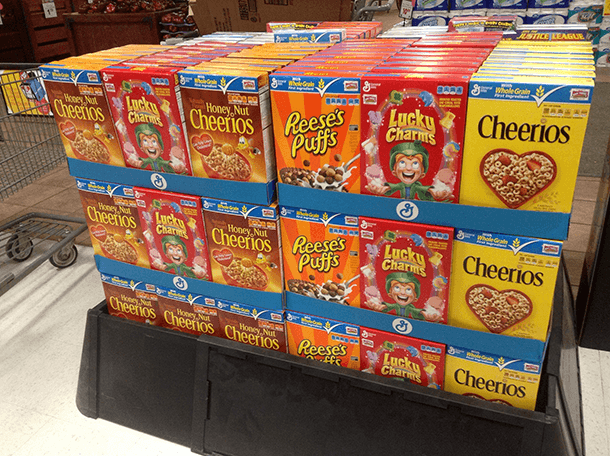Food giant General Mills announces a new push for sustainable practices
General Mills makes many different products; its cereals include Cheerios, Lucky Charms and Reese’s Puffs.
General Mills, the $20 billion dollar-a-year, Minnesota-based food giant whose brands include Cheerios, Betty Crocker, Haagen Dazs, Pillsbury and Yoplait, has announced an increased commitment to reduce greenhouse gas emissions and to push for more sustainable practices.
General Mills joins other multinationals, such as Unilever and Walmart, that, faced with extreme weather events and drought that threaten the world’s food supply — and company profits — are beginning to adopt new practices to fight global warming
“As part of our efforts to conserve and protect the natural resources that we depend on as a business, we announced a commitment to reduce our absolute emissions by 28 percent versus our 2010 baseline … by 2025,” says Jerry Lynch, General Mills vice president and chief sustainability officer. “To get to sustainable emission levels by 2050, based on the best scientific consensus, that would point to somewhere between a 50 and 70 percent reduction."
According to Lynch, the company has already made absolute greenhouse gas reduction levels of 13 percent since 2005. But only about 15 percent of those emissions occur inside the company’s own four walls. Two-thirds of their emissions are ‘upstream,’ in agriculture, the largest being in dairy and in the row crops they purchase to make their products.
Lynch says General Mills will be partnering with the Field to Market Alliance for Sustainable Agriculture, a group that includes seed and input companies; grower groups like the Wheat Farmers of America; aggregators like Cargill and Bunge; food companies like themselves; large retailers, such as Walmart; the USDA; and most of the major environmental organizations.
“In order for us to make a difference in where we need to be as a planet,” Lynch says, “we really have to address the full value chain, for the sake of our business and the sake of consumers that consume our products.”
Lynch says the company hopes to accomplish this by “leading growers to innovation that is more sustainable and proving to them that more sustainable choices are more resilient and profitable choices.”
“We have a group of oat growers engaged in this work,” he explains. “They measure their sustainability impacts across six different criteria right now, including greenhouse gas emissions and soil carbon. Every year we help them look at that data and some of the best practices that we're seeing elsewhere that can lead to more sustainable and profitable choices.”
“It really is a matter of working with progressive farmers,” he says. “And farmers then tell each other about how this is making a difference in their own operations, and leads the full community in that direction.”
Reducing emissions from milk production involves breaking the problem down to its three main parts, Lynch says.
One is the emissions from the crops that cows eat. These can be reduced through better use of fertilizers, better use of energy and building resilient soils that actually sequester carbon, Lynch says.
An organization called The Dairy Innovation Center is helping to address the second part through a project called The Cow of the Future. The goal is to reduce the animals’ emissions level through diet, herd management and regulation of gestation cycles so that the cow is as healthy as possible, Lynch says.
The third piece is manure management. The Dairy Innovation Center, working with USDA, has made a commitment to roll out several hundred bio-digesters that take dairy waste and turn it into energy and nutrients that can go back onto crops, as well as bedding for the animals.
“The Dairy Innovation Center has set a goal to reduce greenhouse gas emissions on US fluid milk by 25 percent by 2020,” Lynch says. “So bringing that into our own supply chain will make a big difference in addressing this goal.”
Ultimately, addressing climate change as a company is about survival, Lynch says — on every level.
“There are a number of risks that it presents to our livelihoods, and to our business, and to the shared planet if we don't address them,” he says. “It plays a major role in the health of ecosystems that support our consumers and our agriculture.”
Climate change is going to place particular stress on some very vulnerable regions of the world that are important to the company, Lynch notes. Two countries in West Africa — Côte d’Ivoire and Ghana — produce 70 percent of the world’s cocoa; 90 percent of the worlds vanilla is purchased in Madagascar (“We’re pretty dependent on that vanilla for Haagen Dazs,” Lynch notes.) 80 percent of the world’s almonds come from California, which is experiencing its worst drought in its history.
“So we think it's important to act,” Lynch says. “Because we’ve got to manage the risk in our supply chain and because consumers and customers are increasingly asking us to be part of the solution.”
This article is based on an interview that aired on PRI's Living on Earth with Steve Curwood
The World is an independent newsroom. We’re not funded by billionaires; instead, we rely on readers and listeners like you. As a listener, you’re a crucial part of our team and our global community. Your support is vital to running our nonprofit newsroom, and we can’t do this work without you. Will you support The World with a gift today? Donations made between now and Dec. 31 will be matched 1:1. Thanks for investing in our work!
